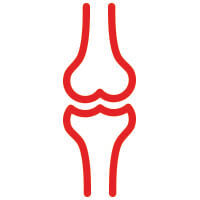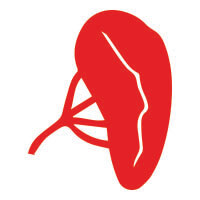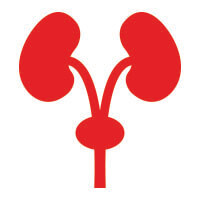Lungs
The lungs are the most commonly affected organ in sarcoidosis. Ninety percent or more of people with sarcoidosis have lung involvement, whether they have symptoms or not. Symptoms specific to sarcoidosis affecting the lungs include:
- Dry coughing
- Trouble breathing, wheezing, or pain with breathing
- Chest pain, tightness, or discomfort
- Coughing up blood (which is rare), especially in the early stages of sarcoidosis.
There are many problems that can be caused by sarcoidosis affecting the lungs, usually only in the most serious cases. Those problems include:
- Pulmonary Fibrosis: scarring that occurs in the lungs as a result of untreated or unyielding inflammation/granuloma formation. As scar tissue builds up in the walls of air sacs in the lungs, it can make it hard for oxygen to get into your blood over time, leading to reduced oxygen levels in the blood and shortness of breath. Pulmonary fibrosis belongs to a larger group of lung diseases called “interstitial lung diseases,” another way in which your doctor might refer to your condition.
- Fibrocystic disease: an advanced form of lung disease in which scars block airways in one or both lungs
- Pulmonary hypertension: a condition in which scar tissue narrows or blocks arteries in the lungs, causing high blood pressure. The high blood pressure, also known as hypertension, forces the heart to work harder to pump blood through the vessels. Over time, heart muscle builds up and weakens, hindering its ability to deliver oxygen to lungs and other parts of the body.
- Bronchiectasis: condition in which the walls of the bronchi, or airways in the lungs, thicken due to chronic inflammation/granuloma formation. Overtime, bronchi become unable to clear out mucus. The mucus then builds up, creating an environment where bacteria will grow. Over time, the airways become inflamed, stretched out, and scarred, making it harder for the lungs to move air through them.
- Aspergilloma: a clump of fungus that forms in healed lung scars and enlarged airways, and can cause bleeding in the lungs.
Learn more on our pulmonary sarcoidosis page.
Lymph Nodes

Most commonly, it is the lymph glands in the chest that are affected, but this can be hard to detect without an x-ray. Some of the other places affected by enlarged lymph nodes (they appear as swollen lumps) include:
- Neck
- Under the chin
- Armpit
- Groin
Unlike during a cold or the flu, swollen lymph nodes in these areas are not usually tender when associated with sarcoidosis.
Skin

Skin problems might include:
- Erythema nodosum, which causes raised, red, and tender bumps to form on the skin, usually on the front of the legs. Nearby joints are often swollen and painful. Erythema nodosum usually goes away on its own in six to eight weeks, even without treatment. Often, the presence of erythema nodosum is a good sign, indicating the type of sarcoidosis that also goes away on its own after a few months or years.
- Lupus pernio, which is an uncommon skin condition that causes hard, reddish-purplish bumps to form on the cheeks, nose, lips, and/or ears. These bumps do not go away on their own and often come back when treatment is stopped. They are usually associated with chronic sarcoidosis. In some cases, the sores are disfiguring and can damage underlying cartilage and bone.
- Other bumps on or under the skin, rashes, sores, scaling, and/or changes in old scars or tattoos that do not go away and are rarely painful or itchy. These skin problems are associated with the kind of sarcoidosis that lasts a long time.
Eyes

Eye symptoms can include:
- Burning, itching, and/or pain
- Dryness
- Tearing
- Red eyes
- Vision problems, such as seeing black spots or having blurred vision
- Sensitivity to light
- Small, pale yellow bumps on the eye
Eye problems caused by sarcoidosis might include:
- Uveitis (the most common eye problem), which is inflammation of the middle membrane – or the uvea – of the eye.
- Dry eye syndrome (also called keratoconjunctivitis), which occurs when the tear ducts are blocked by inflammation.
- Tear gland enlargement (also called lacrimal gland enlargement), which occurs when the tear glands are swollen by inflammation and granulomas.
- Glaucoma, cataracts, and blindness, which are rare but serious problems that can occur if uveitis goes untreated.
Heart

Learn more on our cardiac sarc page.
Some people with heart involvement might notice symptoms, but many people will feel no obvious effect, even in late-stage disease.
Heart symptoms might include:
- Irregular heartbeats, which can feel like palpitations and/or skipped beats
- Shortness of breath, coughing, chest tightness, and/or wheezing (although these symptoms can also be associated with lung problems)
- Swelling in the legs, which usually occurs only in late-stage sarcoidosis of
the heart - Feeling lightheaded or fainting
The problems caused by cardiac sarcoidosis can include:
- Arrhythmias, which are abnormal heartbeats or rhythms.
- Heart blocks, which are the blockage of electrical impulses that regulate the heart rate, impairing blood flow to the rest of the body.
- Heart failure, which occurs when the heart is unable to pump enough blood through the body, causing blood and fluid to back up in the lungs and elsewhere.
- Pericarditis, which although rare, can cause inflammation of the covering of the heart, as well as chest pain.
- Heart valve problems, which can prevent blood from flowing through the heart correctly.
- Heart attacks, which can occur when a blockage prevents blood and oxygen from reaching part of the heart.
Learn more on our cardiac page.
Brain and Nervous System

Brain and nervous system symptoms can include:
- Facial palsy (also called Bell’s palsy), which causes drooping and/or paralysis on one side of the face (the most common nervous system symptom)
- Headaches
- Eye pain and redness
- Blurry or double vision
- Blindness
- Weakness, numbness, tingling, and/or pain in the face, arms, and/or legs
- Arm and/or leg paralysis
- Seizures
- Behavior and mood changes, irritability, memory loss, and hallucinations (which are rare)
The problems caused by sarcoidosis of the nervous system can include:
- Nerve inflammation and/or damage, which results in many of the symptoms described above, depending on which nerves are affected. For example, facial palsy is a result of damage to a nerve or nerves at the base of the brain.
- Peripheral neuropathy, which is a condition that impairs the nerves’ ability to transmit messages between the brain and spinal cord and the rest of the body. It can cause the weakness and numbness described previously.
- Masses of granulomas in the meninges, or more rarely, in the brain, which cause the headaches, vision problems, and muscle weakness described previously. These masses can also cause meningitis, hydrocephalus, neuroendocrine disorders, and coma (see below).
- Meningitis, which is inflammation of the meninges, the membranes that surround your brain and spinal cord.
- Hydrocephalus, which is excess cerebrospinal fluid in the skull. It might occur with or after meningitis.
- Neuroendocrine disorders, which affect how the nervous and endocrine systems interact (the endocrine system makes and secretes hormones). When sarcoidosis damages an area at the base of the brain called the hypothalamus, it can lead to neuroendocrine disorders, such as hypopituitarism (an underactive pituitary gland).
- Coma, although this is rare.
Bones, Joints, and Muscles
S
Musculoskeletal symptoms might include:
- Early-onset arthritis, which causes joint pain, stiffness, and/or swelling that usually occurs in the first six months of the disease, begins suddenly in one or both of the ankles and/or feet, and sometimes involves the knees, toes, fingers, wrists, and/or elbow joints. It often accompanies erythema nodosum (described previously in SKIN), and it usually goes away on its own in a few weeks or months.
- Late-onset arthritis, which usually occurs six months or more after sarcoidosis develops, is less painful and affects fewer joints than early-onset arthritis (usually the knees and/or ankles, or sometimes the fingers or toes). It is often associated with chronic skin symptoms (described previously in SKIN) rather than erythema nodosum. This type of arthritis can last for a long time, a lifetime, or it may come and go. It usually does not go away for good without treatment like early-onset arthritis does. It can cause permanent joint damage and should be treated even when it is not painful.
- Bone cysts (which are rare)
- Muscle aches or muscle pain (also called myalgia)
- Muscle weakness
Problems caused by musculoskeletal sarcoidosis can include:
- Permanent bone and joint damage, which occurs from the formation of granulomas and cysts on the bones or from chronic arthritis. Such damage is rare, but when it does occur, it often affects the hands.
- Bone thinning (also called low bone density or osteopenia), which occurs when microscopic holes develop in the bones, making them weaker and more prone to fracture.
- Chronic myopathy, which is a general term for muscle weakness or muscle disease that lasts a long time or a lifetime. It is uncommon, but when it does occur, it is more likely to affect women.
Spleen

Sarcoidosis of the spleen does not usually cause symptoms, but possible symptoms may include:
- Pain on the upper left side under the ribs
- A sensation of pressure in the same area
- Feeling tired
Some of the problems sarcoidosis might cause when it affects the spleen include:
- Spleen enlargement (also called splenomegaly), which occurs when inflammation and the formation of granulomas cause the spleen to swell.
- Anemia, which occurs when blood does not contain enough healthy red blood cells to carry sufficient oxygen to the body’s tissues, and can cause fatigue.
- Leukopenia, which occurs when there are not enough white blood cells circulating through the body, and makes the body prone to infections.
- Thrombocytopenia, which occurs when the body does not have enough of the circulating blood platelets necessary for blood clotting.
Liver

Liver symptoms may include:
- Fever
- Feeling tired or fatigued
- Itchy skin
- Jaundice, which causes skin and eyes to look somewhat yellow
- Pain on the upper right side under the ribs
The liver problems caused by sarcoidosis might include:
- Liver enlargement (also called hepatomegaly), which occurs when inflammation and granulomas on the liver cause it to swell.
- Abnormal liver enzyme levels, which is a common problem, but not usually a serious one.
- Portal hypertension, which is a rare complication defined as high blood pressure in the main blood vessel that carries blood to the liver. When pressure on this vein prevents normal blood flow, the blood must return to the heart through other blood vessels. These blood vessels become swollen and fragile due to the extra load.
- Cirrhosis, which is a rare condition that occurs when inflammation and granulomas scar the liver.
Kidneys and Urinary Tract

Kidney and urinary tract symptoms include:
- Pain in the back or side, just under the ribs, which can be caused by large kidney stones.
- An increased urge to urinate, which is also caused by kidney stones.
Kidney problems caused by sarcoidosis might include:
- Too much calcium in the blood (also called hypercalcemia), which occurs in roughly 10 percent of people with sarcoidosis.
- Too much calcium in the urine (also called hypercalciuria), which occurs in roughly a third of people with sarcoidosis.
- Kidney stones, which are fairly uncommon.
- Loss of kidney function or kidney failure, which is often due to excessively high calcium levels in the blood or urine.
Salivary Glands
Sinuses



